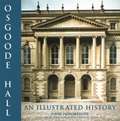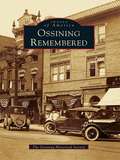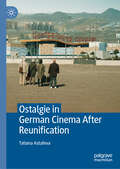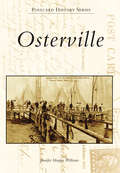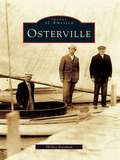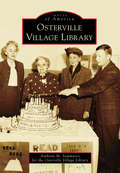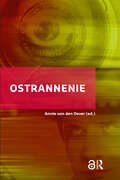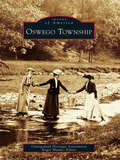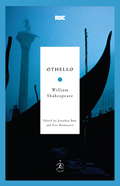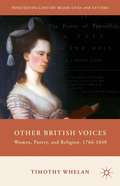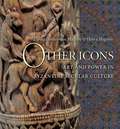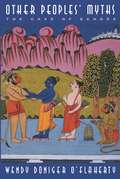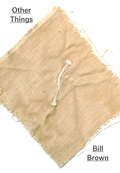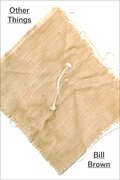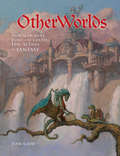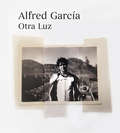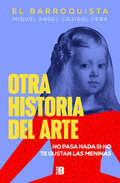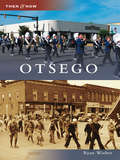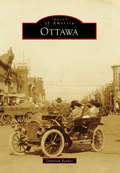- Table View
- List View
Osgoode Hall: An Illustrated History
by John HonsbergerWinner of the 2006 Fred Landon Award Osgoode Hall is a national monument and one of the architectural treasures of Canada. Of the many public buildings erected in pre-confederation Canada and British North America, it best encapsulates the diverse stylistic forces that shaped public buildings in the first half of the nineteenth century. The gated lawns, grandly Venetian rotunda, the noble dimensions of its library, handsome and ornate courtroom, portrait-lined walls and stained glass evoke a venerable dignity to which few Canadian institutions even aspire. It has been the seat of the Law Society of Upper Canada since 1832 and of several of the Superior Courts of the province for almost as long. Intended to be the focal point of the legal profession in Upper Canada it has become a symbol of the legal tradition not only in Ontario but throughout Canada and beyond.
Ossining Remembered (Images of America)
by The Ossining Historical SocietyOssining commands a position high on the banks of the Hudson River, at the edge of Westchester County, New York. Perhaps best known as the location of Sing Sing Prison, Ossining is rich in history and in personal memories. The history and memories come through clearly in this book of exceptional photographs. Ossining Remembered focuses on the heart of the town, from Main Street out to the river. Included are images of places that made downtown Ossining the dynamic community it once was--the theater, the cigar store, and the bakery. Also featured are vintage photographs of the riverfront mansions and estates, the numerous educational institutions and churches, and, of course, the famous prison.
Ostalgie in German Cinema After Reunification
by Tatiana AstafevaThis book provides a thorough overview of the ostalgie films about the German Democratic Republic (GDR) produced since the 1990s. Far from being a homogenous phenomenon that romanticizes the totalitarian state, the ostalgie genre is multifaceted, reflexive, and at times subversive. Thus, Astafeva argues, the core of "ostalgie" is an experience of distance that is ‘prefocused’ by various aesthetic strategies. This genre-based definition makes it possible to conceptualize the phenomenon of ostalgie film in its heterogeneity and to reveal the mechanisms that lay in the essence of ostalgic experience. The cognitivist-phenomenological approach is underpinned by historiographic and genre theory and close analysis of film examples—from the most popular ostalgie films such as Goodbye, Lenin! (Wolfgang Becker, 2003) to lesser-known film productions and recent series such as Kleo (2022–2024)—that allow exploration of various functions of the ostalgic experience. Ostalgie films can foster uncritical reactionary and conservative views of history and expose the experience of distance by orienting aesthetics toward kitsch and retro. They can also encourage reflexive and meta-reflexive understandings of history so that the GDR past is critically discussed and reworked. Furthermore, ostalgie films can in some cases activate historical consciousness, facilitate the production of historical knowledge, and generate ethical thinking and empathy.
Osterville
by Jennifer Morgan WilliamsIn the late 1800s, Osterville emerged as a destination. People would arrive by stagecoach and train to stay at the many inns and lodges around this coastal village. West Bay Inn and East Bay Lodge became social gathering spots where people would stay for weeks or months. Churches, family markets, and the library lined Main Street. In 1914, the Crosby family designed a special racing class of boats--the Wianno Seniors. The Wianno Senior Knockabouts were commissioned by the wealthy families that founded the exclusive clubs Seapuit, Osterville-Wianno, and Oyster Harbors; Osterville-Wianno and Oyster Harbors are still known for their golf courses and are enjoyed by residents and visitors today.
Osterville (Images of America)
by Shirley EastmanThe tiny seaside village of Osterville was settled in the 1700s by hardy Colonists determined to make a living harvesting oysters. The village is home to the Crosby Yacht Yard, which has been turning out superior craft since the 1840s. Pres. John F. Kennedy often sailed his Crosby Wianno Senior on Nantucket Sound when he vacationed at his Cape Cod home. Osterville follows this town's evolution, from a haven for captains of great merchant ships to a summer playground for such storied families as the Mellons and DuPonts. Today, Osterville's superb beaches and laid-back lifestyle attract not only the rich and famous but also year-round residents who enjoy a relaxed and sophisticated lifestyle.
Osterville Village Library (Images of America)
by Anthony M. LibSince its beginnings in 1882, the Osterville Village Library has long fulfilled its founding promise to be “a free library and reading room at Osterville in the Town of Barnstable in this Commonwealth” and to support “the promotion of study and reading.” William Lloyd Garrison Jr. and a group of civic-minded residents led the effort to establish this fourth library on Cape Cod. It has seen tremendous growth since then, with the opening of a new library designed by Stanley Alger of Alger & Gunn in 1958, followed by a new state-of-the-art library designed by Charles Bellingrath and completed by Jeremiah Ford of Ford3 Architects in 2012. The Osterville Village Library is justifiably the pride of Osterville, from its professional and welcoming staff and generous supporters to its cupola that boasts a copper weather vane of the Wianno Senior.
Ostrannenie: On "Strangeness" and the Moving Image. The History, Reception, and Relevance of a Concept (The Key Debates: Mutations and Appropriations in European Film Studies)
by Annie van den OeverOstrannenie (‘making it strange’) has become one of the central concepts of modern artistic practice, ranging over movements including Dada, postmodernism, epic theatre, and science fiction, as well as our response to arts. Coined by the ‘Russian Formalist’ Viktor Shklovsky in 1917, ostrannenie has come to resonate deeply in Film Studies, where it entered into dialogue with the Brechtian concept of Verfremdung, the Freudian concept of the uncanny and Derrida's concept of différance. Striking, provocative and incisive, the essays of the distinguished film scholars in this volume recall the range and depth of a concept that since 1917 changed the trajectory of theoretical inquiry.
Oswego Township (Images of America)
by Oswegoland Heritage Association Roger MatileIn 1832, John, Walter, and Daniel Pearce, and their brother-in-law, William Smith Wilson, walked west from their homes in Ohio prospecting for land. When they reached the Fox River in the vicinity of modern Oswego, they agreed they had found the place they wanted to settle. The next year, 1833, after selling their Ohio farms, they traveled west by wagon with their families and became the first settlers in Oswego Township. Just two years later, Lewis B. Judson and Levi F. Arnold laid out a new village on land first claimed by Wilson, creating the foundation of today's bustling village of Oswego. A stagecoach route crossroads, the seat of KendallCounty for nearly 20 years, and a market town for the surrounding agricultural area, Oswego grew steadily until the Civil War. After the war, growth slowed until the second half of the 20th century when the area began to boom, both in population and economically. This book offers many of the area's newest residents a chance to look back at Oswego Township's rich heritage.
Otafuku: Joy of Japan
by Yutaka Satoh Amy Slyvester KatohWith dozens of color photographs and fun, informative text, this guide to Japanese otafuku is a delight for collectors or Japanese culture enthusiasts.Anywhere you go in Japan you are likely to encounter the plump, smiling image of Otafuku. <P><P>Author Amy Sylvester Katoh traces the roots and folk beginnings of this mythic figure, showing Otafuku's many delightful identities, and providing a magical glimpse into this charming character who has become a national icon.With a mixture of poems, photographs, anecdotes, and stories, she presents a veritable treasure chest of surprises that is sure to enchant readers.
Othello: Le More De Venise... (Modern Library Classics)
by William Shakespeare Jonathan Bate Eric RasmussenThough this great tragedy of unsurpassed intensity and emotion is played out against Renaissance splendor, its story of the doomed marriage of a Venetian senator’s daughter, Desdemona, to a Moorish general, Othello, is especially relevant to modern audiences. The differences in race and background create an initial tension that allows the horrifyingly envious villain Iago methodically to promote the “green-eyed monster” jealousy, until, in one of the most deeply moving scenes in theatrical history, the noble Moor destroys the woman he loves–only to discover too late that she was innocent.Each Edition Includes:• Comprehensive explanatory notes • Vivid introductions and the most up-to-date scholarship • Clear, modernized spelling and punctuation, enabling contemporary readers to understand the Elizabethan English• Completely updated, detailed bibliographies and performance histories • An interpretive essay on film adaptations of the play, along with an extensive filmography
Other Axis & Allied Armored Fighting Vehicles: World War II AFV Plans (AFV Plans)
by George BradfordThis fully illustrated volume presents an authoritative and highly detailed study of WWII&’s lesser-known armored fighting vehicles. The iconic tanks of WWII, such as America&’s Shermans and the Germany&’s Panzers, have been exhaustively studied. In Other Axis & Allied Armored Fighting Vehicles, military historian and technical artist George Bradford offers an in-depth look at a range of significant yet often-overlooked models. This volume is filled with fine-scale drawings of Australian, Belgian, Canadian, Czech, French, Hungarian, Italian, Japanese, Polish, Romanian, and South African armored vehicles, including: · Centauro Tank Destroyer (Italy) · TKS Light Reconnaissance Tank (Poland) · Ram &“Kangaroo&” Personnel Carrier (Canada) · Renault R-35 Light Tank (France) · Type 3 Chi-nu Heavy Tank (Japan) · Scorpion AC1 Cruiser Tank (Australia) · TACAM R-2 Tank Hunter (Romania) · And many, many more . . .
Other British Voices: Women, Poetry, and Religion, 1766-1840 (Nineteenth-Century Major Lives and Letters)
by Timothy WhelanOther British Voices.
Other Icons: Art and Power in Byzantine Secular Culture
by Henry Maguire Eunice Dauterman MaguireA winged centaur with the spotted body of a leopard playing a lute; a naked man with an animal head; a goat-footed Pan; a four-bodied lion; sphinxes, and hippocamps. Few would associate these forms of art with the Byzantine era, a period dominated by religious art. However, an art of strikingly secular expression was not only common to Byzantine culture, but also key to defining it.In Other Icons, Eunice Dauterman Maguire and Henry Maguire offer the first comprehensive view of this "unofficial" Byzantine art, demonstrating the role it played and its dialogue with traditional Christian Byzantine art. This beautifully illustrated book creates an entirely new understanding of the whole of Byzantine art and culture.With its wide-ranging examples, the book vividly demonstrates how the surprise of this "profane" art is not only in its subjects of mythic creatures, exotic imagery, and eroticism, but also in the ubiquity and beauty of their placement--within churches and without, woven into silk, illuminated on manuscripts, engraved into pottery, painted in frescoes, and taking life in marble, bone, and ivory.By presenting and exploring this profane art for the first time in a scholarly book in English, Other Icons will change the way we look at the art of an entire era.
Other Planes of There: Selected Writings
by Renée GreenFor more than two decades, the artist Renée Green has created an impressive body of work in which language is an essential element. Green is also a prolific writer and a major voice in the international art world. Other Planes of There gathers for the first time a substantial collection of the work she wrote between 1981 and 2010. The selected essays initially appeared in publications in different countries and languages, making their availability in this volume a boon to those wanting to follow Green's artistic and intellectual trajectory.Charting this cosmopolitan artist's thinking through the decades, Other Planes of There brings essays, film scripts, reviews, and polemics together with reflections on Green's own artistic practice and seminal artworks. It immerses the reader in three decades of contemporary art showcasing the art and thought, the incisive critiques and prescient observations of one of our foremost artists and intellectuals. Sound, cinema, literature, time-based media, and the relationship between art forms and other forms of knowledge are just a few of the matters that Green takes up and thinks through. Sixty-four pages of color plates were selected by the artist for this lavishly illustrated volume.
Other Things
by Bill BrownFrom the pencil to the puppet to the drone--the humanities and the social sciences continue to ride a wave of interest in material culture and the world of things. How should we understand the force and figure of that wave as it shapes different disciplines? Other Things explores this question by considering a wide assortment of objects--from beach glass to cell phones, sneakers to skyscrapers--that have fascinated a range of writers and artists, including Virginia Woolf, Man Ray, Spike Lee, and Don DeLillo. The book ranges across the literary, visual, and plastic arts to depict the curious lives of things. Beginning with Achilles's Shield, then tracking the object/thing distinction as it appears in the work of Martin Heidegger and Jacques Lacan, Bill Brown ultimately focuses on the thingness disclosed by specific literary and artistic works. Combining history and literature, criticism and theory, Other Things provides a new way of understanding the inanimate object world and the place of the human within it, encouraging us to think anew about what we mean by materiality itself.
Other Things
by Bill BrownFrom the pencil to the puppet to the drone—the humanities and the social sciences continue to ride a wave of interest in material culture and the world of things. How should we understand the force and figure of that wave as it shapes different disciplines? Other Things explores this question by considering a wide assortment of objects—from beach glass to cell phones, sneakers to skyscrapers—that have fascinated a range of writers and artists, including Virginia Woolf, Man Ray, Spike Lee, and Don DeLillo. The book ranges across the literary, visual, and plastic arts to depict the curious lives of things. Beginning with Achilles’s Shield, then tracking the object/thing distinction as it appears in the work of Martin Heidegger and Jacques Lacan, Bill Brown ultimately focuses on the thingness disclosed by specific literary and artistic works. Combining history and literature, criticism and theory, Other Things provides a new way of understanding the inanimate object world and the place of the human within it, encouraging us to think anew about what we mean by materiality itself.
OtherWorlds: How to Imagine, Paint and Create Epic Scenes of Fantasy
by Tom KiddGo where no artist has ever gone before. Bizarre terrains, enchanted forests, futuristic metropolises, ornate palaces ... these are the places where adventure dwells. In this fun and fiercely original book from celebrated fantasy artist Tom Kidd, you'll learn how to set the scene for epic tales of adventure. Discover where Kidd finds his best ideas, the methods behind his glorious color sense, and how he turns it all into exquisite skies, glittering cities, spectacular rock formations, stormy seas, magnificent forests and other bold, breathtaking vistas. Learn to draw and paint fantastic settings in a way that makes them utterly believable Get imagination-sparking approaches for dreaming up these strange new realms, seeing the world around you with fresh eyes and finding ready inspiration in the most ordinary of places 13 step-by-step demonstrations show how ideas are developed into dynamic color oil and watercolor renderings, with some discussion of digital techniques This book is your ticket to destinations of absolute wonder and bizarre beauty. Thrill your viewers by transporting them to locales so vast and unreal, it will take their breath away.
Otra Luz
by Alfred GarcíaEste conjunto de poemas, canciones y fotografías de Alfred García son el cuaderno de bitácora de su última gira y de algunas impresiones que tuvo a partir de su participación en Operación Triunfo, Eurovisión y de la creación de su disco 1016. Sus textos e instantáneas nos permiten conocer su mundo íntimamente. «Los que le conocéis y cantáis sus temas en los conciertos, que no para de ofrecer en esta gira interminable, sabéis de lo que hablo. Muchos días actúa por convicción, pero, como buen músico de jazz, sabe que la improvisación lo es todo en la vida, más para un individuo tan intuitivo como él.»David Castillo, periodista, escritor y biógrafo de Dylan
Otra historia de la arquitectura: Por qué tu casa es mejor que Versalles
by Miguel Ángel Cajigal Vera (El Barroquista)Tras el éxito de Otra historia del arte, vuelve El Barroquista con un libro imprescindible que nos invita a reflexionar sobre por qué la arquitectura es el mejor antídoto contra el olvido histórico. ¿Sabes por qué en tu casa vives mejor que Catalina la Grande en el palacio de invierno de San Petersburgo o que Luis XVI en Versalles? ¿Por qué la reina Isabel II de Inglaterra se largaba en cuanto podía de su residencia oficial a su castillo privado con habitaciones mucho más pequeñas? ¿Qué lecciones y polémicas oculta la famosa torre Eiffel? La casa en la que te acuestas y despiertas cada día es arquitectura. La escuela en la que estudiaste es arquitectura. Igual que lo es la oficina en la que trabajas, el gimnasio, el cine, la discoteca o los museos en los que pasas tu tiempo libre… La arquitectura nos acompaña -de manera más o menos evidente- en cada uno de nuestros pasos cotidianos, e influye en nuestras vidas más que cualquier otra disciplina creativa. Y, sin embargo… ¡no le prestamos ninguna atención! Este libro reúne conceptos fundamentales y todas las claves para analizar la arquitectura más allá de los clichés, nos enseña a apreciar los diferentes tipos de construcciones para entender cómo cada una de ellas se pensó para satisfacer distintas funciones según la época y lugar y nos abre los ojos a las diferencias sociales y culturales a través de la historia de los edificios.
Otra historia del arte: No pasa nada si no te gustas Las Meninas
by Miguel Ángel Cajigal Vera (El Barroquista)La Historia del Arte con uno de los grandes divulgadores de España: @ElBarroquista. Cualquiera que haya visitado un museo o haya hojeado un libro sobre arte habrá escuchado o leído frases rimbombantes y categóricas como «Nos encontramos ante la gran obra maestra del siglo XX», «Este artista es un genio» o «Aquella pintura cambió el mundo». Esta concepción de la creación artística -basada en la aceptación de un canon preestablecido que privilegia unos estilos específicos y encumbra unas firmas concretas-, lejos de favorecer el aprendizaje y hacer el arte más accesible, ha encorsetado el placer del público general y ha condicionado su gusto. En este libro, el historiador del arte Miguel Ángel Cajigal Vera -conocido como El Barroquista en su labor divulgativa- propone una nueva manera de acercarnos a esta disciplina y nos invita a disfrutar del arte sin prejuicios y con total libertad. Otra historia del arte es un ensayo estimulante que nos abre las puertas al museo particular del autor, donde conoceremos historias fascinantes y obras personalísimas, como las de Maurizio Cattelan, Teresa Margolles, Piero Manzoni o Fiona Banner, junto a piezas muy reconocidas de Guo Xi, Frida Kahlo o Artemisia Gentileschi. Y tras finalizar la lectura comprenderemos por qué no pasa nada si no nos gustan Las meninas.
Otsego
by Ryan WieberOtsego has a rich and storied past as one of the earliest settlements in southwest Michigan. Founded in 1831, its character has been shaped by a history filled with agriculture, tourism, fascinating people, and remarkable commerce--particularly the manufacturing of paper. Otsego has seen the rise and fall and recent rebirth of the local papermaking industry, and it is now poised to progress through the 21st century with a renewed sense of vigor.
Otsego and Plainwell (Images of America)
by Ryan Wieber Sandy StammIn 1831, Samuel Foster and his family built a log house near the rapids of the Kalamazoo River at what is now downtown Otsego. Soon others interested in utilizing the power afforded by the river set up sawmills and grain mills for newly arriving settlers, and the beginnings of a town quickly took shape. In the 1900s, Otsego became synonymous with the paper industry, and for a while, seven paper mills were in operation at the same time. Plainwell, originally called Plainfield and the Junction, situated itself at the crossroads of the old plank roads that led to Grand Rapids, Kalamazoo, and Allegan. Here too, the paper industry played an important part in the growth of Plainwell. Since the downtown area is completely surrounded by the Kalamazoo River and a millrace, it is now referred to as the Island City." Plainwell's historic heritage is evident today through its quaint downtown architecture and beautifully restored neighborhood homes. Otsego and Plainwell have grown up close to each other and share their stories, families, and traditions."
Ottawa
by Deborah BarkerOttawa was founded in 1864. Located in the Marais des Cygnes River Valley, the area's rich soil and lush grass made it well suited for growing crops and pasturing livestock. The community's first cultural center was Ottawa University, which was chartered in 1865 and built on land exchanged by the Ottawa Indians for the promise of an education for their children. Two railroads later arrived, the Lawrence, Leavenworth & Galveston in 1868 and the Missouri Pacific in 1880, spurring industrial development. Images of America: Ottawa highlights early settlers, prominent industries, noteworthy institutions, and devastating natural disasters. Using vintage photographs, this history features local memories and milestones, capturing everything from the famous Ottawa Chautauqua Assemblies, held annually from 1883 to 1914 in Forest Park, to the emerging distribution centers that have shaped the area today.
Otto Preminger: Interviews (Conversations with Filmmakers Series)
by Gary BettinsonOtto Preminger (1905–1986), whose Hollywood career spanned the 1930s through the 1970s, is popularly remembered for the acclaimed films he directed, among which are the classic film noir Laura, the social-realist melodrama The Man with the Golden Arm, the CinemaScope musical Carmen Jones, and the riveting courtroom drama Anatomy of a Murder. As a screen actor, he forged an indelible impression as a sadistic Nazi in Billy Wilder’s Stalag 17 and as the diabolical Mr. Freeze in television’s Batman. He is remembered, too, for drastically transforming Hollywood’s industrial practices. With Exodus, Preminger broke the Hollywood blacklist, controversially granting screen credit to Dalton Trumbo, one of the exiled “Hollywood Ten.” Preminger, a committed liberal, consistently shattered Hollywood’s conventions. He routinely tackled socially progressive yet risqué subject matter, pressing the Production Code’s limits of permissibility. He mounted Black-cast musicals at a period of intense racial unrest. And he embraced a string of other taboo topics—heroin addiction, rape, incest, homosexuality—that established his reputation as a trailblazer of adult-centered storytelling, an enemy of Hollywood puritanism, and a crusader against censorship. Otto Preminger: Interviews compiles nineteen interviews from across Preminger’s career, providing fascinating insights into the methods and mindset of a wildly polarizing filmmaker. With remarkable candor, Preminger discusses his filmmaking practices, his distinctive film style, his battles against censorship and the Hollywood blacklist, his clashes with film critics, and his turbulent relationships with a host of well-known stars, from Marilyn Monroe and Frank Sinatra to Jane Fonda and John Wayne.
